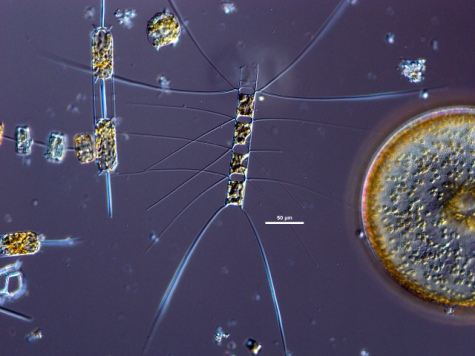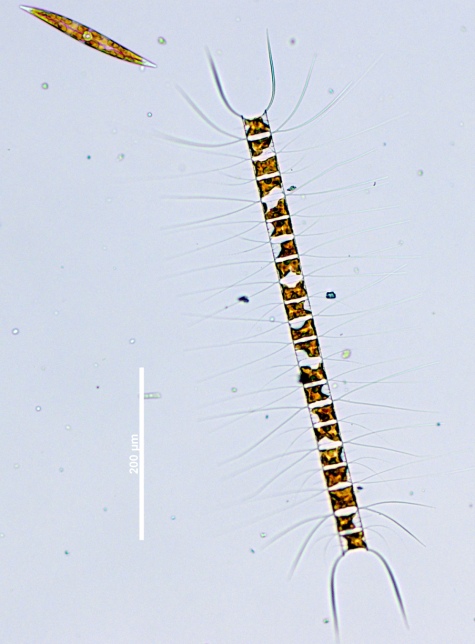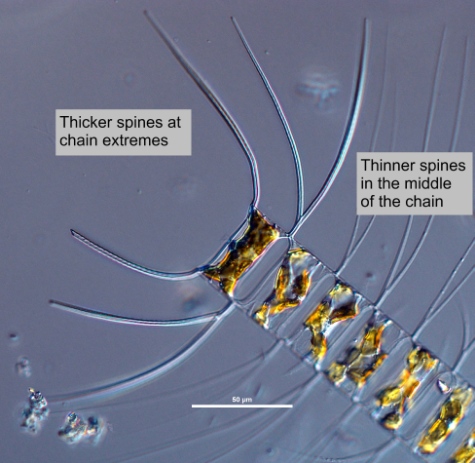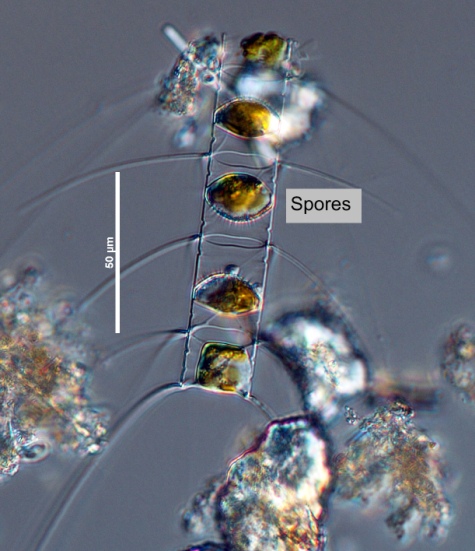



|
Synonym(s)
Heterotypic
A difference in type. In naming species, a heterotypic synonym is one that comes into being when a taxon becomes part of a different taxon. Compare to homotypic.
(heterotypic)C. lorenzianus: Chaetoceros cellulosus Launder 1864 (heterotypic)
(Guiry and Guiry 2012)
*C. lorenzianus is sometimes referred to as C. lorenzianum (Guiry 2012).
Classification
(Guiry and Guiry 2012)
Lifestyle
Description
Valve
In diatoms, the structurally distinct halves of the cell wall (Becker 1996).
Valves are concave, with the corners directly in contact with adjacent cells. Spines arise from the corners and are usually fused with adjacent spines for a short distance before diverging. CloseAperture
"In some diatoms, the space between the valves of adjacent cells in chains" (Horner 2002).
Apertures range from narrow to CloseOvoid
Oval or egg-shaped.
ovoid. Chloroplasts are numerous (4 - 10), large, and plate-like (Cupp 1943). Cells are yellow-brown in colour.Measurements
Apical
(axis, spine) The region of the apex or point. Refers to the most anterior point or region of the cell (HPP 2003).
(apical axis): 7 - 85 μmLength Close
Pervalvar axis
The axis through the centre point of the two valves of a frustule. This axis is perpendicular to the valve face.
(pervalvar axis): 9 - 35 μm(Hasle and Syvertsen 1997, Kraberg et al. 2010)
Similar species
Harmful effects
Habitat
Distribution
C. decipiens is cosmopolitan, while C. lorenzianus is found in temperate waters (Hasle and Syvertsen 1997).
C. decipiens occurs mainly during spring in Northern European seas (Kraberg et al. 2010). C. lorenzianus can be abundant during winter and spring in the East China Sea (Luo et al. 2007) and during winter in coastal lagoons in Florida (Badylak and Philips 2004).
C. decipiens is usually abundant from early spring to early summer, and C. lorenzianus is common off California (Cupp 1943).
Growth conditions
Environmental Ranges
Temperature range (°C): -1.899 - 29.468
Nitrate (μmol L-1): 0.053 - 28.280
Salinity: 19.590 - 36.252
Oxygen (mL L-1): 4.444 - 9.192
Phosphate (μmol L-1): 0.046 - 2.337
Close
Silicic acid
A general term to describe chemical compounds containing silicon, oxygen and hydrogen with a general formula of [SiOx(OH)4-2x]n. Diatoms polymerize silicic acid into biogenic silica to form their frustules (Azam and Chisholm 1976).
Silicate (μmol L-1): 0.687 - 59.039(OBIS 2012, cited in EOL 2012)
Bloom characteristics
References
Badylak, S. and Philips, E. J. 2004. Spatial and temporal patterns of phytoplankton composition in a subtropical coastal lagoon, the Indian River Lagoon, Florida, USA. Journal of Plankton Research. 26(10): 1229-1247.
Cupp, E. E. 1943. Marine Plankton Diatoms of the West Coast of North America. University of California Press. Berkeley, California. 238.
Encyclopedia of Life (EOL). 2012. Chaetoceros. http://eol.org/pages/12010/overview. Accessed 31 Mar 2012.
Guiry, M. D. 2012. Chaetoceros Ehrenberg, 1844. http://www.marinespecies.org/aphia.php?p=taxdetails&id=148985. Accessed 31 Mar 2012.
Guiry, M. D. and Guiry, G. M. 2012. Chaetoceros Ehrenberg, 1844: 198. http://www.algaebase.org/search/genus/detail/?genus_id=43689. Accessed 31 Mar 2012.
Hasle, G. R. and Syvertsen, E. E. 1997. Marine diatoms. In: Tomas, C. R. (ed.) Identifying Marine Phytoplankton. Academic Press, Inc., San Diego. 5-385.
Kraberg, A., Baumann, M. and Durselen, C. D. 2010. Coastal Phytoplankton: Photo Guide for Northern European Seas. Verlag Dr. Friedrich Pfeil, Munchen, Germany. 204.
Luo, M. B., Lu. J. J., Wang, Y. L., Shen, X. Q. and Chao, M. 2007. Horizontal distribution and dominant species of phytoplankton in the East China Sea. Acta Ecologica Sinica/Shengtai Xuebao. 27(12): 5076-5085.
Ocean Biogeographic Information System (OBIS). 2012. Chaetoceros. http://www.iobis.org/mapper/?taxon_id=611649. Accessed 31 Mar 2012.
